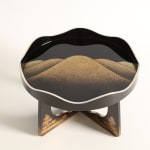Yasuhara Shōsō
Offering Stand with Distant Hills and Pine Saplings, 1930s
Maki-e gold lacquer on wood; silver rim
Size 7 x 12 x 12 in. (18 x 30.5 x 30.5 cm)
T-5025
Further images
-
(View a larger image of thumbnail 1
)

-
(View a larger image of thumbnail 2
)

-
(View a larger image of thumbnail 3
)

-
(View a larger image of thumbnail 4
)

-
(View a larger image of thumbnail 5
)

-
(View a larger image of thumbnail 6
)

-
(View a larger image of thumbnail 7
)

-
(View a larger image of thumbnail 8
)

-
(View a larger image of thumbnail 9
)

A circular sanbō (offering stand), the seven-lobed tray supported on a cruciform stand cut with large suhama-shaped openings, the wood body finished in polished black roiro lacquer and decorated in...
A circular sanbō (offering stand), the seven-lobed tray supported on a cruciform stand cut with large suhama-shaped openings, the wood body finished in polished black roiro lacquer and decorated in gold hiramaki-e and hirame, the tray with a stylized symmetrical range of five mountains, the stand with pine saplings, the rims in pure silver.
Comes with its original fitted paulownia-wood tomobako storage box inscribed outside Enzan wakamatsu maki-e maru-sanbō (Circular Offering Stand with Distant Hills and Pine Saplings in Maki-e); signed Maki-eshi Shōsō (Maki-e master Shōsō) and sealed Shōsō
Yasuhara Shōsō was the son of Yasuhara Kiyoshi, a native of Kanazawa—a center of lacquerware production during the Edo period (1615-1868)—who had moved to Osaka to engage in the manufacture of goods for export. Taking over the business in 1899, Shōsō started to show his work at exhibitions in the second decade of the twentieth century, graduating to national level in 1927 when he first participated in the Teiten national salon; he would exhibit a further five times, finishing in 1940 at the great exhibition held to commemorate the 2600th anniversary of the Japanese Imperial house. Adapting time-honored motifs and exploiting to the full his mastery of the traditional techniques of Kaga maki-e, the sophisticated decorating tradition that had developed in Kanazawa over the previous three centuries under the patronage of the wealthy Maeda family, Shōsō forged a distinctive modern style that echoes similar achievements by his contemporaries in the fields of metalwork and ceramic decoration.
Comes with its original fitted paulownia-wood tomobako storage box inscribed outside Enzan wakamatsu maki-e maru-sanbō (Circular Offering Stand with Distant Hills and Pine Saplings in Maki-e); signed Maki-eshi Shōsō (Maki-e master Shōsō) and sealed Shōsō
Yasuhara Shōsō was the son of Yasuhara Kiyoshi, a native of Kanazawa—a center of lacquerware production during the Edo period (1615-1868)—who had moved to Osaka to engage in the manufacture of goods for export. Taking over the business in 1899, Shōsō started to show his work at exhibitions in the second decade of the twentieth century, graduating to national level in 1927 when he first participated in the Teiten national salon; he would exhibit a further five times, finishing in 1940 at the great exhibition held to commemorate the 2600th anniversary of the Japanese Imperial house. Adapting time-honored motifs and exploiting to the full his mastery of the traditional techniques of Kaga maki-e, the sophisticated decorating tradition that had developed in Kanazawa over the previous three centuries under the patronage of the wealthy Maeda family, Shōsō forged a distinctive modern style that echoes similar achievements by his contemporaries in the fields of metalwork and ceramic decoration.
1
of
31








